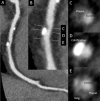Latest Advances in Cardiac CT
- PMID: 32180833
- PMCID: PMC7066830
- DOI: 10.15420/ecr.2019.14.2
Latest Advances in Cardiac CT
Abstract
Recent rapid technological advancements in cardiac CT have improved image quality and reduced radiation exposure to patients. Furthermore, key insights from large cohort trials have helped delineate cardiovascular disease risk as a function of overall coronary plaque burden and the morphological appearance of individual plaques. The advent of CT-derived fractional flow reserve promises to establish an anatomical and functional test within one modality. Recent data examining the short-term impact of CT-derived fractional flow reserve on downstream care and clinical outcomes have been published. In addition, machine learning is a concept that is being increasingly applied to diagnostic medicine. Over the coming decade, machine learning will begin to be integrated into cardiac CT, and will potentially make a tangible difference to how this modality evolves. The authors have performed an extensive literature review and comprehensive analysis of the recent advances in cardiac CT. They review how recent advances currently impact on clinical care and potential future directions for this imaging modality.
Keywords: CT coronary angiography; Cardiac CT; atherosclerosis; cardiovascular disease risk; coronary artery calcium score; coronary artery disease; fractional flow reserve CT; machine learning.
Copyright © 2020, Radcliffe Cardiology.
Conflict of interest statement
Disclosure: The authors have no conflicts of interest to declare.
Figures





References
-
- Kelion AD, Nicol ED. The rationale for the primacy of coronary CT angiography in the National Institute for Health and Care Excellence (NICE) guideline (CG95) for the investigation of chest pain of recent onset. J Cardiovasc Comput Tomogr. 2018;112:516–22. doi: 10.1016/j.jcct.2018.09.001. - DOI - PubMed
-
- British Society of Cardiovascular Imaging, Royal College of Radiologists. Fatal heart conditions going undetected due to lack of scanning services. Nov 8, 2018. https://bsci.org.uk/wp-content/uploads/2019/01/idor_2018_uk_release.pdf (accessed 18 December 2019)
Publication types
LinkOut - more resources
Full Text Sources

